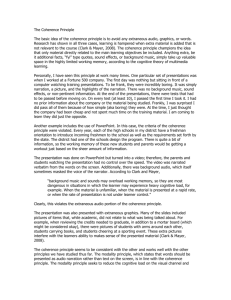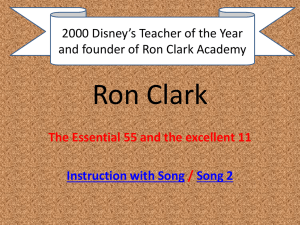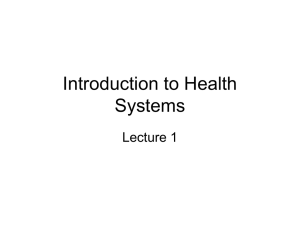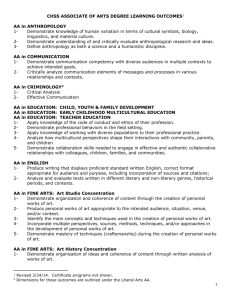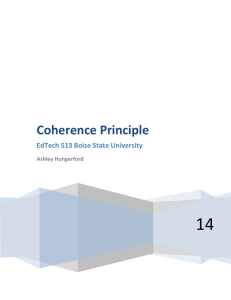Coherence Analysis - Boise State University
advertisement
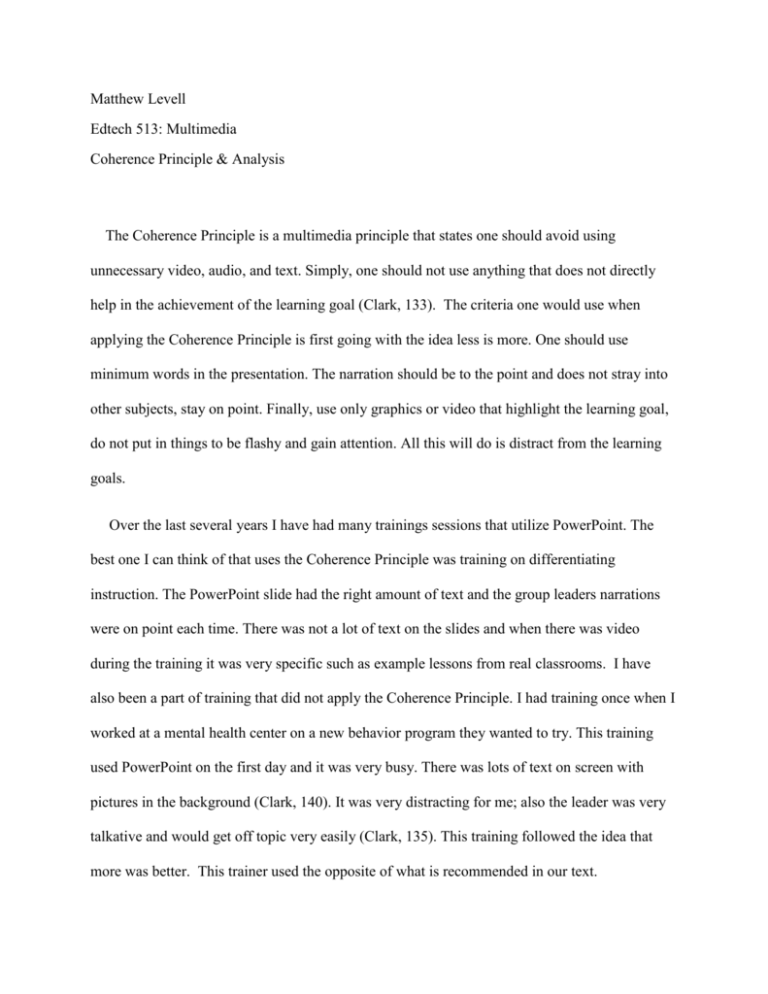
Matthew Levell Edtech 513: Multimedia Coherence Principle & Analysis The Coherence Principle is a multimedia principle that states one should avoid using unnecessary video, audio, and text. Simply, one should not use anything that does not directly help in the achievement of the learning goal (Clark, 133). The criteria one would use when applying the Coherence Principle is first going with the idea less is more. One should use minimum words in the presentation. The narration should be to the point and does not stray into other subjects, stay on point. Finally, use only graphics or video that highlight the learning goal, do not put in things to be flashy and gain attention. All this will do is distract from the learning goals. Over the last several years I have had many trainings sessions that utilize PowerPoint. The best one I can think of that uses the Coherence Principle was training on differentiating instruction. The PowerPoint slide had the right amount of text and the group leaders narrations were on point each time. There was not a lot of text on the slides and when there was video during the training it was very specific such as example lessons from real classrooms. I have also been a part of training that did not apply the Coherence Principle. I had training once when I worked at a mental health center on a new behavior program they wanted to try. This training used PowerPoint on the first day and it was very busy. There was lots of text on screen with pictures in the background (Clark, 140). It was very distracting for me; also the leader was very talkative and would get off topic very easily (Clark, 135). This training followed the idea that more was better. This trainer used the opposite of what is recommended in our text. So far we have been learning about several principles when it comes to multimedia. I would like to first highlight the Cognitive Principle of Multimedia and how it relates to the Coherence Principle. The Cognitive Principle states first that we have dual channels of learning these are visual and auditory. If we have too much information going down one path then it will have an effect on our learning (Clark, 36). This is very much what the Coherence Principle states. One does not want too much graphics or too much text. When looking how the Coherence Principle relates to the Modality Principle, let’s first look at the Modality Principle. The Modality Principle simple put is the idea that when using narration it is better with video/graphics, but if you pair video, narration, and text, learners seem to suffer (Clark, 99). This goes right along with the Coherence Principle again because if you pair all three video, narration, and text that is too much and interferes with learning. In the Clark & Mayer book they discuss different psychological reasons for using the Coherence Principle. The first being why not use extra audio, they state that a lot of people believe that you need to get and keep the learner’s attention. This is called the Arousal Theory. The Arousal Theory states that one needs to entertain leaners. In reality all this does is distract the learners and keeps them from learning. By adding all the extra in to try to keep learners interested you’re not getting them interested in the learning objective, but interested in the extra audio or whatever you may be using (Clark 137-138). They go on to discuss how adding pictures into your presentation will help the students be more emotionally connected to the learning (Clark, 142). In reality the use of graphics and audio clips can be distracting. Whereas using text just interferes with teaching (Clark, 148). There are three reasons stated on why people put extra text in their presentation. First, for adding interest, second is to expand on an idea, and finally to apply technical detail. In all there is no reason to add extra words in anything, because the goal you have is to help the learners. Instead the entire extra will do nothing but hinder that purpose. I personally agree with the Coherence Principle. I believe too much stuff going on in a multimedia presentation is distracting for me. If one stops and starts to think about younger students with some possibly with some form of ADHD you can see how too many graphics or sounds could be a problem. To them it would be all about the cool thing that being audio, or video, or anything else. It takes away from the educational goal that you are trying to achieve by using multimedia. The one thing I think they did not address well or not at all is the idea of not enough. I would think that if someone is really concerned about following the Coherence Principle it could be easy to fall into a trap of not having enough. I always would side on the side of cautions, but always keep in mind that if a good video or audio clip will help enhance your presentation in anyway, I believe it is worth it. Reference Clark, R.C., & Mayer, R. (2008). E-Learning and the Science of Instruction. San Francisco: Pfeiffer.

